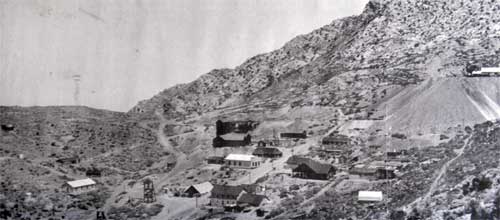|
My primary vision of
Cerro Gordo
has always been one of a bustling mining town, full of the men that
worked in the mines, and the businessmen who provided the necessary
supplies and services that would have been needed for day to day life.
The few women in town would have been those like Lola Travis and Maggie
Moore who ran the dance halls, and palaces of pleasure. There were no
churches, or schools. Yet, in spite of that, some of those miners and
businessmen actually did bring wives and children to live on the hill
with them.
A
Stroll Through Town
In The Story of Cerro Gordo, by Mrs. J. S. Gorman, better known
to readers of Explore Historic California as young Lulu Wapplehorst, the
first bride of
Cerro Gordo
, we are given a rare
glimpse into what life was like growing up on the old Fat Hill. As we
walk through town, through the eyes of Mrs. Gorman, we are reminded of
the cabins on the outskirts of town that not only housed miners, but in
some cases, their families as well. While there were cabins that were
well built with two or three rooms, proper doors and windows, apparently
others were put together in such hast that they really didnít look
much different in the 1870ís than they do in the year 2004. Mrs.
Gorman describes the latter as sagging and dipping at their corners and
creaking horribly with the almost constantly howling wind. Old sacks and
pieces of flattened out tin served as windowpanes instead of glass.
Pity the poor family that had to live under these circumstances!
|

|
|
View
of Cerro Gordo circa 1916, during the zinc mining era. The Union
Mine hoist house is at the far right. |
In addition to the cabins, the blacksmith shops stood on the
fringe of town. Imagine the loud clanking, ringing, banging, as the
great freight wagons, stagecoaches and others were repaired, and the
horses and mules that drove these vehicles were shoed. Also imagine the
flying dust as these various modes of transportation found their way
through town. Proceeding further into town, small eateries, boarding
houses, saloons and dance halls, doctors and lawyers offices would have
appeared.
Only a few restored buildings and remnants of others remain on
the mountain today. At one time main street was full of restaurants both
plain and fancy and there were two double storied hotels breaking the
otherwise barren skyline. The
buildings were so many and so close, that they actually elbowed each
other. Late in the afternoons, the men came from the mines and smelters
in such groves, that the young Lulu Lewis could barely force her way
along the streets. Except for dinnertime, the miners would surge in and
out of the saloons and dance halls. The flare of the Beaudry and Belshaw
furnaces lit the town as the men gathered in groups on the street late
into the night.
The
Jingle of the Freight Wagons
Although Remi Nadeauís freight contract had expired long before
Luluís wedding took place, his wagons must have been the most
fantastic spectacle that ever came up and down the mountain - the chain
of three blue painted wagons, the long string of 14-20 mules, and the
jingle of the lead bells they wore. The muleskinner sat a top one of the
wheelers, shouting and cursing as he popped the blacksnake whip, and the
mules snorted, coughed, and whinnied, as their hooves thundered along
the dirt streets. The lead ďschoonersĒ each had wheels five feet
high and six inches wide. The wooden hulls of each wagon were tall and
narrow, and carried the necessary water barrels on each of their sides.
The freight capacity of each wagon was ten tons, but most loads ran a
bit less than that. Heading
out of town, when the mining was at itís best, they would have carried
170 silver ingots that weighed 87 pounds each.
Read
More
|

